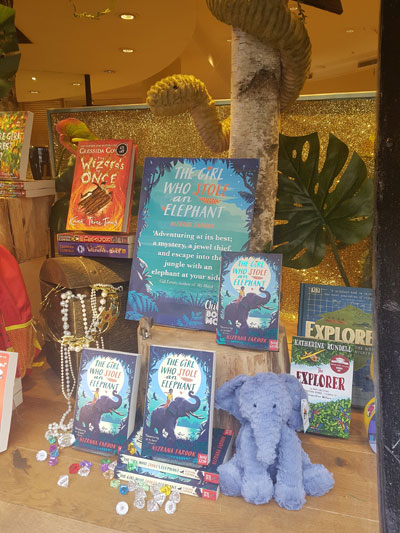A tropical delight from a promising new Lankan author

Dream debut: Nizrana Farook
An exotic, jungle-like window display at Waterstones, Piccadilly- Europe’s largest bookstore- throws the red carpet for a new Sri Lankan book- ‘The Girl who Stole an Elephant’ by Nizrana Farook.
The children’s novel had a warm welcome all over the UK in the brittle heart of winter early this year. It was the Waterstones’ children’s book for January. Among many displays in bookshop windows, decorated with antique bejewelled elephants, glittering gems, stuffed pythons and twirling tropical ferns and foliage, were these words by a critic:
“As rich, dazzling, and alluring as a pouchful of royal jewels, and as triumphant as a trumpeting elephant.”
This is the story of little Chaya- who reminds you of Joan Aiken’s cocky heroine Dido Twite- a spry and fiery chick sparrow of a girl- rather winning (even sans Dido’s colourful cockney chatter).
A girl-Robin Hood in essence, Chaya steals from the rich, and helps the poor.
In an e-mail interview with the Sunday Times, Nizrana says the character was born at a class at Bath Spa University where she was following an MA in writing for children. “Fight or flight” were the words for the day on the board, and Nizrana came up with a young girl fleeing from a palace after stealing the queen’s jewels.
It took time for the little tomboy to materialize fully- and for Nizrana to sketch in the details of her world, but finally a novel grew out of the short piece.
The pouchful of jewels that Chaya steals from the queen’s suite are meant to be spent on medicine for a boy bitten by a crocodile. But things do not follow their intended course and Chaya with friends Neelan and Nour are sprung on an adventure- which involves being imprisoned, escaping on an elephant, trampling through rainforests, battling leopards and finally saving the kingdom from a despot enthroned in his mountain citadel.
The Serendib that Nizrana evokes, however, is a collage. There is much geographical licence, says Nizrana. The Sigiriya-like citadel sits next to a rainforest that covers half the island, while patently Dutch mansions and opulent Arab merchants exist together- unlike in a real timeline.
The atmosphere is deftly caught- whether it is the heart of a Buddhist temple, the king’s rock citadel palace, a village carpenter’s shed or a rich merchant’s demesne set around an inner courtyard.

The Girl who stole an elephant:Jungle-like window display at Waterstones
This patchwork of an ‘alternative’ history tugs your memory back to Joan Aiken, while the warring royals and amicable elephants also suggest Aiken’s famous book, Wolves of Willoughby Chase.
But Nizrana, growing up, never read Aiken. Living in Colpetty, she schooled at Methodist College. Nizrana is grateful to the pragmatic school with its ‘value placed on English’- fostering writers like Ruwanthie de Chickera and Prashani Rambukwella- both her classmates who won the Gratiaen.
It was while at school she had her one brush with the rainforest, which later would provide refuge for her characters fleeing the king’s wrath.
The girls in her ‘A’Level class still remember their trip to the Sinharaja. Nizrana’s characters on the royal elephant go crashing through the jungle as recalled from that memorable trip- evoking the high canopied green cathedral- mysterious, ferny, dark and wet.
The jungle in the book is more abundant than your tropical rainforest actually is. This denotes an exile’s thirst- a craving for the tropical fruit and shade of her homeland. “It was written in winter,” Nizrana says, “but I made the story as bright and sunny and as tropical as I could make it.”
She brings that world of tropical bounty to life with a feathery touch- as delicious as banana or pineapple- or the shade of a palm or a great banyan. “One child wrote to me that she is curious to try different fruits after reading.” Another wrote that she could feel herself in that setting. In the gloom of winter, Nizrana’s nostalgia had created a luscious tropical paradise.
But her current home in Hertfordshire brightens in summer with the woods behind her house, and has more wildlife than Colpetty ever did. Red foxes nightly raid bins and “lately the muntjac deer too wander in”.
While the tomboy with the cheeky repartee is a literary favourite with universal appeal- at first Nizrana was unsure how British children would respond to a Sinhalese girl (plus a Tamil boy and a Muslim girl).
“Children around the world read British books, but traditionally speaking British children only read about themselves- or about others through their own lens.” But things are changing.
Thanks to the exotic brush of illustrator David Dean who shrouds the pages with shadowy jungle silhouettes you feel you are in the womb of this hauntingly lush world.
The response for the book has been overwhelming- and is still growing. Nizrana, meanwhile, is writing an adventure set in the same classic world of Serendib but with different characters – due to break cover by January 2021.
A promising voice from home to keep track of!



